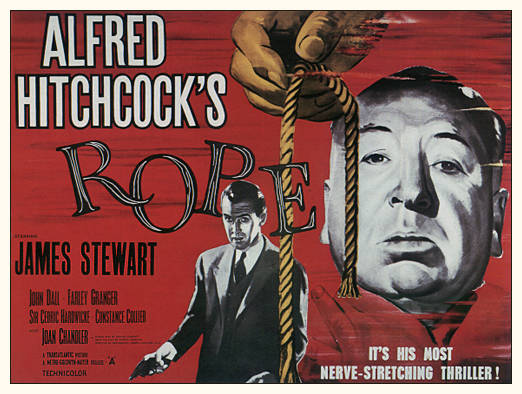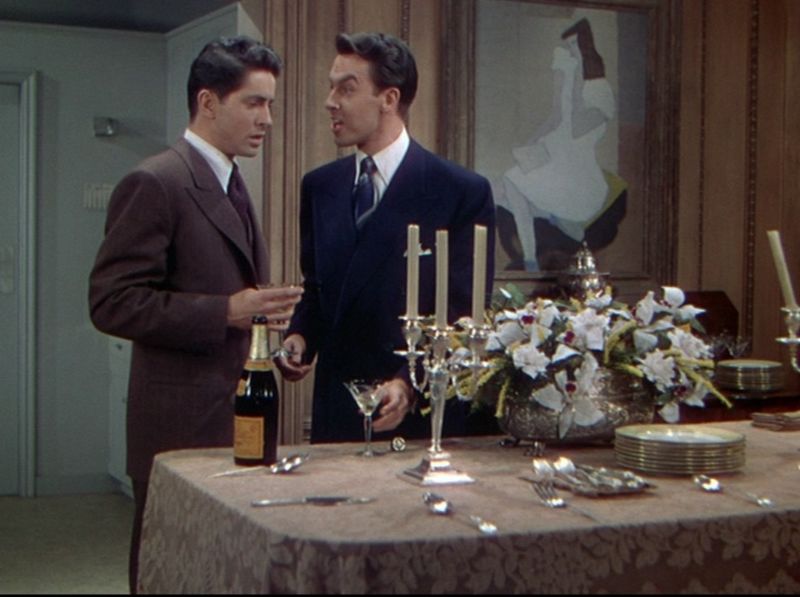Rope (1948)
 Tuesday, July 22, 2014 at 9:06PM
Tuesday, July 22, 2014 at 9:06PM 
Having almost 10 films by the Master of Suspense under my belt, I had planned to continue on into those from the 1950s and beyond. However I’ve now backtracked slightly into 40s with Shadow of a Doubt, and this little experiment he performed a few years later. Rope was a film I had already seen once before, but now I was better able to examine as opposed to being slightly wowed by this unique film infamous for being completed in “one” take.
Brandon and Phillip have just murdered a supposedly close friend (for those cinebriates out there, they really don’t appreciate that he likes Whiskey, so best to drink fine wine here for your own saftey) and with a warped sense of humor have hid the body at a party attended by the victim’s family and friends. While Brandon is perfectly comfortable with this willing to risk exposure for excitement, Phillip is struggling with the guilt and hardly has the misguided courage Brandon does. With a brilliant mentor in attendance who has known the two since they were kids, what on the surface seems a dull get-together for the high class turns slowly into a fairly suspenseful real-time experience, all due to our indirect voyeurism.
Many older films can’t be completely timeless (poor video quality, clichés the modern audience has come to associate with dated cinema, etc.) but one area where this film stands out is the technique used to hide cuts (Hitch couldn't completely have a seamless take even if he wanted to as the camera wouldn't hold enough film). This being completed roughly 66 years ago, you can’t help but be in awe of the technique as it is something still not seen often today. This is not the all-encompassing reason for Rope standing the test of time, but it certainly helps.
Right away you can see similarities to previous films of the Master of Suspense, including the even more claustrophobic Lifeboat, a very effective paranoid WWII thriller all on the eponymous craft. Also both involve Hume Cronyn as he starred in that film and wrote this. Shadow of a Doubt may come to mind with Rope acting as an almost spiritual spinoff, with Brandon and Phillip acting as Young Charley's father and his friend (Another Hume connection as he played that character!) would in another life, carrying out their perverted obsession with murder.

For this, my second round with the film, I certainly found issues unseen previously, including the acting by John Dall (who plays Brandon). Philip is certainly a guilt-ridden woose, but understandably so while Brandon’s eager excitement is overly exaggerated in the opening scenes (too much emphasis on stuttered breathing). All I see is a performer at first, though we eventually understand a slight relevant to the plot as James Stewart’s character mentions that Brandon is always hiding something when in that physical state.
Also, there are moments where I can't help but not see a good reason for doing it in one simulated take (cuts are made in darkness of a character’s back), except for a few fairly wonderful moments. One that comes to mind is Brandon swinging the titular rope (murder weapon) as he takes it to the kitchen. The maid comes out and the door swings back and forth behind her, with one instance showcasing a brief moment of Brandon in ecstasy as he places the murder weapon in the drawer for all to see. Just as well, because we become so used to a continuous and fluid shot, this technique is effective for the surprising hard cut hard cut in the center of the film during a moment of realization by the mentor Rupert (James Stewart, in his first of many Hitchcock film, playing a great supporting character whose reputation being discussed much before he is onscreen adds to the charisma when he does show up). Without the ongoing take, the cut would be nowhere near as effective or poignant.
An experiment to be sure, but overall an effective one that keeps with the Master’s style, and even better showcases the exceptional talents of Hume who can write and act. It also deftly moves from point to point in conversation and plot, which is fairly impressive in this day and age.
If you don’t like that sort of thing though, the new Transformers film is in theaters now.
 Cinebriated,
Cinebriated,  Hitchcock,
Hitchcock,  Hitchcock Chaser,
Hitchcock Chaser,  Suspense,
Suspense,  Thriller in
Thriller in  Hitchcock Chasers
Hitchcock Chasers 


Reader Comments